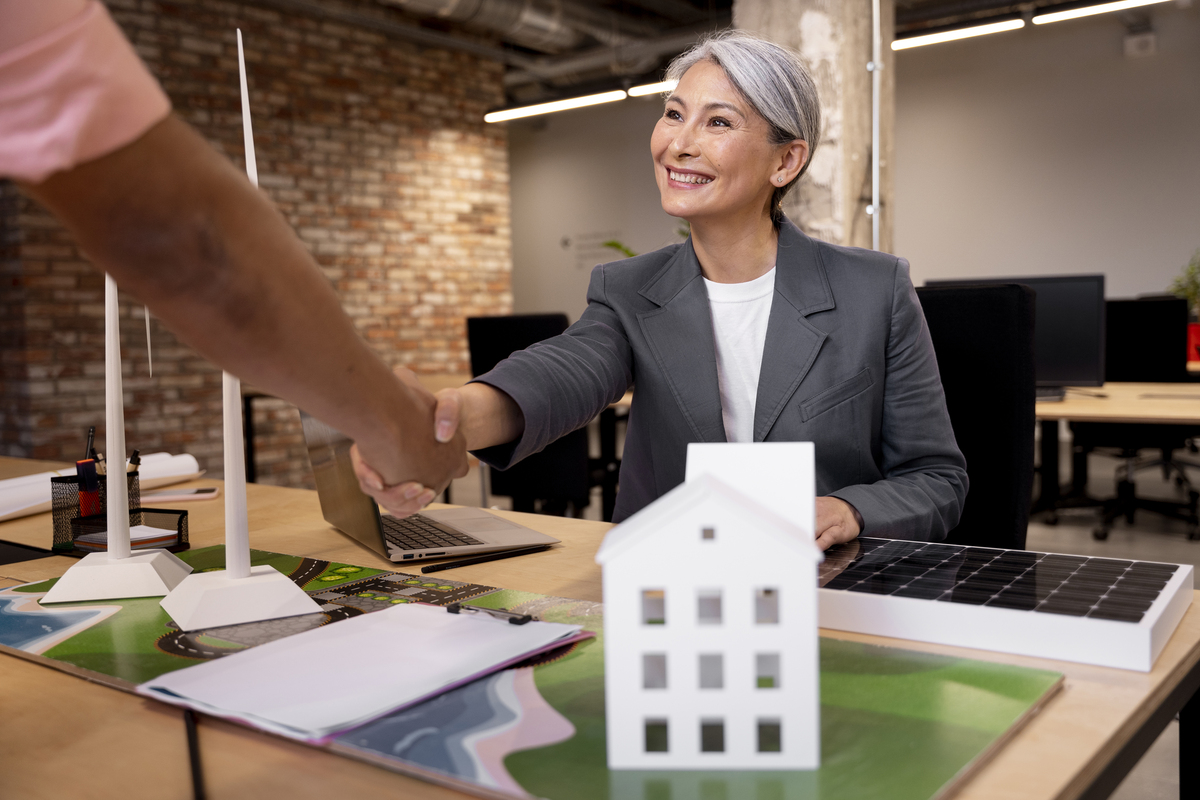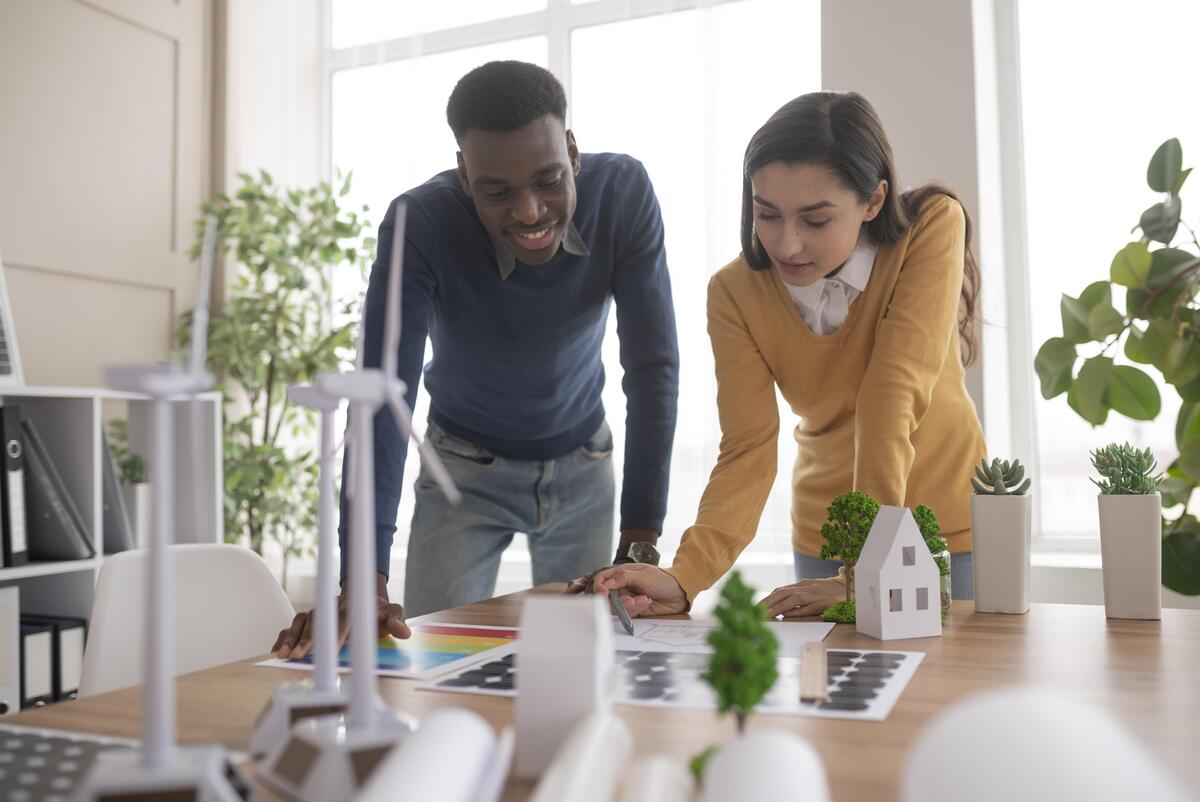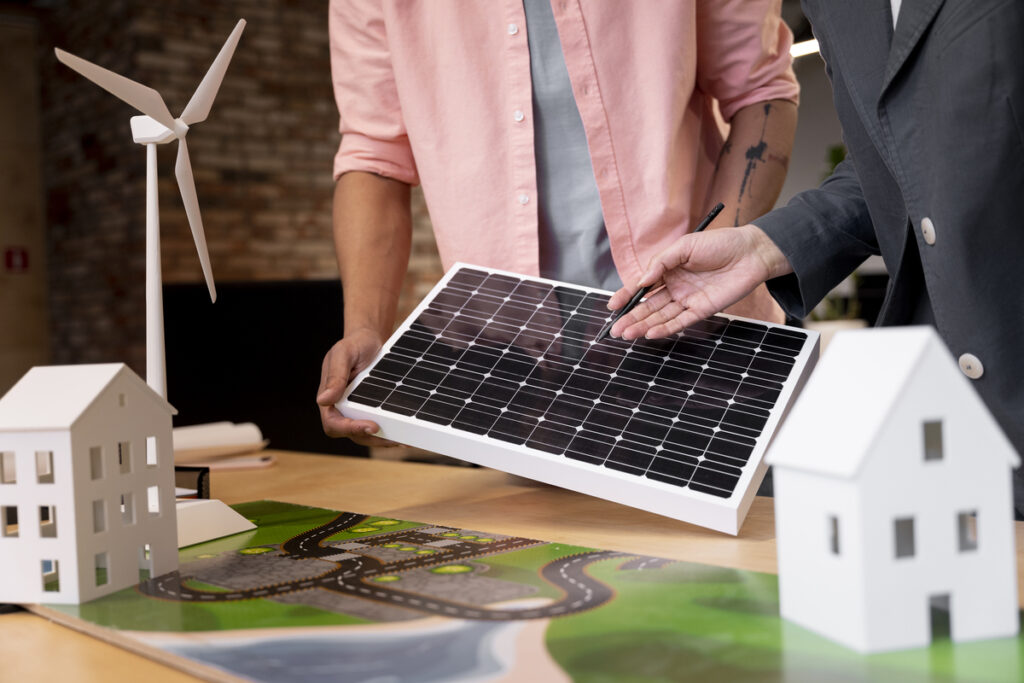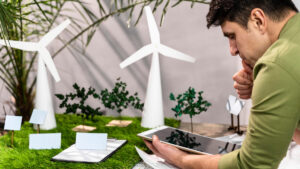Updated by Nazanin Ghodsian, 08/06/2024
With over 7.8 billion people on the planet and rising urbanization, there is a greater need than ever for sustainable construction and energy efficiency in buildings. Approximately 28% of carbon dioxide emissions and over 30% of all energy use worldwide are attributed to buildings. As a result, they play a big role in environmental degradation and climate change.
To tackle these challenges, integrating green power in building—utilizing renewable energy sources like solar, wind, geothermal, and biomass—has emerged as a crucial strategy. In addition to lowering the carbon footprint in construction, green power in buildings promotes environmental sustainability and improves energy efficiency. We can minimize the effects on the environment, cut running costs, and consume less energy by implementing these technologies into building design and operation.
This review delves into the development of green power in building industry, examining its advantages for the environment and economy, technological breakthroughs, implementation issues, and best practices. Our goal is to provide a clear understanding of how green power may promote the shift toward more sustainable and eco-friendly constructions, providing helpful insights and practical suggestions for stakeholders in the construction and real estate sectors.
Table of Contents
What is Green Power?
The energy landscape in the United States comprises a diverse array of energy sources, each with its environmental implications and costs.
Green power constitutes a specific category within renewable energy, encompassing those renewable resources and technologies that offer the most significant environmental advantages. In the voluntary U.S. market, green power is defined as electricity generated from sources such as solar, wind, geothermal, biogas, eligible biomass, and low-impact small hydroelectric sources. To qualify as green power, this renewable electricity must exceed the standard requirements mandated by regulations. Essentially, green power is characterized by its voluntary nature, going beyond regulatory obligations. Consumers often opt for green power in building due to its emission-free profile and its capacity to reduce carbon footprints.
Suggested article to read: Sustainable Construction; Comprehensive Guide 2024

Evolution of Green Power in Building
The evolution of green power in building has been marked by significant milestones and transformative shifts in architectural and construction practices. Initially, green building concepts emerged as responses to growing environmental concerns, focusing on energy efficiency and resource conservation. Over time, these principles have evolved into comprehensive strategies aimed at reducing the environmental impact of buildings while enhancing occupant comfort and well-being.
Early efforts in green building can be traced back to the energy crisis of the 1970s, which spurred interest in energy-efficient design and renewable energy technologies. The development of rating systems such as LEED (Leadership in Energy and Environmental Design) in the 1990s provided a framework for assessing and certifying green buildings, further promoting their adoption.
The early 21st century witnessed a rapid expansion of green building initiatives worldwide, driven by increased awareness of climate change and the need for sustainable development. Governments, businesses, and individuals began embracing green building practices as integral components of their environmental stewardship efforts.
Suggested article to read: Sustainable Construction Technology; Ultimate Guide in 2024
Technological advancements have played a crucial role in the evolution of green power in building. Innovations in renewable energy technologies, such as solar photovoltaics, wind turbines, and geothermal heat pumps, have made it increasingly feasible to generate clean energy on-site. Additionally, smart building technologies, including energy-efficient lighting, heating, and cooling systems, have enabled greater control and optimization of energy usage.
Moreover, green building practices have become increasingly integrated into urban planning and development strategies. Sustainable building design principles, such as passive solar design, natural ventilation, and green roofs, are being incorporated into new construction projects and retrofitted into existing buildings to minimize environmental impact and maximize energy efficiency.
Looking ahead, the evolution of green power in building is expected to continue as governments, businesses, and communities prioritize sustainability and resilience in the face of climate change. Emerging trends such as net-zero energy buildings, decentralized energy systems, and circular economy principles are poised to reshape the future of the built environment, driving further innovation and advancement in green building practices.
Suggested article to read: Top 24 Sustainable Construction Technologies in 2024
Environmental Benefits of Green Power in Building
The adoption of green power in building offers a plethora of environmental benefits, making it a vital component of sustainable development. These benefits encompass reductions in greenhouse gas emissions, conservation of natural resources, mitigation of climate change impacts, and overall enhancement of environmental quality.
- Reduction of Greenhouse Gas Emissions: Green power sources such as solar, wind, and geothermal energy produce electricity without emitting greenhouse gases like carbon dioxide and methane. By substituting fossil fuel-based electricity generation with renewable alternatives, green buildings contribute to mitigating climate change and reducing the carbon footprint associated with energy consumption.
- Conservation of Natural Resources: Green power in building minimizes reliance on finite and environmentally harmful resources such as coal, oil, and natural gas. Renewable energy sources, such as solar and wind, harness energy from naturally occurring phenomena, thereby preserving finite fossil fuel reserves and reducing environmental degradation associated with resource extraction and combustion.
- Mitigation of Climate Change Impacts on Buildings: Green power adoption plays a crucial role in addressing climate change by reducing the emission of greenhouse gases that contribute to global warming and associated climate-related hazards. By transitioning to renewable energy sources, green buildings contribute to global efforts to limit temperature rise, mitigate the frequency and intensity of extreme weather events, and safeguard ecosystems and biodiversity.
- Enhancement of Air and Water Quality: Unlike conventional energy generation methods, which often result in air and water pollution, green power technologies produce electricity with minimal environmental impact. By avoiding the emission of pollutants such as sulfur dioxide, nitrogen oxides, and particulate matter, green buildings help improve air quality, reduce respiratory illnesses, and mitigate environmental degradation of water bodies and aquatic ecosystems.
- Promotion of Sustainable Land Use: Green power sources, such as rooftop solar panels and wind turbines, can be integrated into existing infrastructure and built environments, thereby minimizing the need for additional land and reducing pressure on natural habitats. By utilizing previously underutilized spaces for energy generation, green buildings contribute to sustainable land use practices and conservation of ecosystems.
Suggested article to read: Discovering the World’s Top 29 Sustainable Buildings
Overall, the environmental benefits of green power in building underscore its significance as a sustainable solution for meeting energy needs while minimizing environmental impact. By embracing renewable energy technologies and implementing energy-efficient building practices, green buildings play a pivotal role in fostering a more resilient and sustainable future for both human societies and the natural environment.

Economic Advantages of Green Power in Building
The integration of green power in building offers a multitude of economic advantages, demonstrating its potential as a financially viable and sustainable investment. These advantages encompass cost savings through energy efficiency measures, long-term return on investment, job creation, and economic growth in the green building sector, as well as financial incentives and government policies supporting green building initiatives.
- Cost Savings through Energy Efficiency: Green power in building often goes hand in hand with energy-efficient design and technologies, resulting in reduced energy consumption and operational construction cost over the building’s lifespan. By optimizing energy use through measures such as insulation, efficient lighting, and smart HVAC systems, green buildings can significantly lower utility bills and operating expenses, translating into long-term cost savings for owners and occupants.
- Long-term Return on Investment (ROI): While the initial upfront costs of integrating green power technologies and sustainable building practices may be higher compared to conventional alternatives, green buildings typically yield substantial returns on investment over time. Studies have consistently shown that the energy savings and other financial benefits associated with green building design and construction outweigh the initial capital expenditures, resulting in higher property values, increased rental rates, and enhanced marketability.
- Job Creation and Economic Growth: The transition to green power in building stimulates economic activity and generates employment opportunities across various sectors of the economy. From manufacturing and installation of renewable energy systems to design, construction, and maintenance of green buildings, the green building sector creates jobs and supports local economies. Moreover, investments in renewable energy infrastructure and energy-efficient technologies contribute to innovation and competitiveness, driving economic growth and prosperity.
- Financial Incentives and Government Policies: Governments at the local, regional, and national levels often provide financial incentives, tax credits, grants, and subsidies to encourage the adoption of green power and sustainable building practices. These incentives aim to offset the initial costs of green building investments, making them more financially attractive to property owners, developers, and investors. Additionally, regulatory frameworks such as building codes, energy standards, and certification programs incentivize compliance with green building principles and promote market transformation toward sustainability.
Suggested article to read: Top 7 Cost Saving Technologies in Construction
Overall, the economic advantages of green power in building underscore its potential to deliver significant financial returns while simultaneously advancing environmental and social goals. By embracing sustainable building practices and investing in renewable energy technologies, stakeholders stand to reap substantial economic benefits while contributing to a more resilient, prosperous, and sustainable built environment.
Technological Innovations Driving Green Power in Building
Technological innovations play a pivotal role in driving the integration of green power in building, enabling the implementation of renewable energy sources and energy-efficient solutions. These innovations encompass advancements in renewable energy technologies, smart building systems, energy-efficient building materials, and design strategies, as well as emerging trends shaping the future of green building.
- Renewable Energy Technologies:
- Solar Photovoltaics (PV): Advances in solar PV technology have led to increased efficiency, reduced costs, and greater flexibility in system design. Innovations such as thin-film solar cells, bifacial panels, and solar tracking systems enhance energy generation and optimize space utilization, enabling widespread deployment of solar power in buildings.
- Wind Turbines: Technological improvements in wind turbine design and manufacturing have boosted efficiency, reliability, and performance, making wind energy an increasingly viable option for on-site and distributed power generation in urban and rural settings.
- Geothermal Heat Pumps: Geothermal heat pump systems utilize the stable temperature of the earth to provide heating, cooling, and hot water, offering significant energy savings and environmental benefits compared to traditional HVAC systems. Advances in geothermal drilling techniques and system design have expanded the applicability of geothermal energy in both residential and commercial buildings.
- Smart Building Systems and IoT Integration:
- Building Energy Management Systems (BEMS): BEMS utilize advanced sensors, controls, and analytics to optimize energy usage, improve occupant comfort, and reduce operating costs. Integrated BEMS platforms enable real-time monitoring, remote control, and automated optimization of building systems, allowing for dynamic response to changing conditions and demand patterns.
- Internet of Things (IoT): IoT technologies enable connectivity and interoperability among building systems, devices, and appliances, facilitating data exchange, analysis, and decision-making. Smart sensors, actuators, and meters embedded within building infrastructure enable intelligent automation, predictive maintenance, and demand response, enhancing energy efficiency and resilience.
- Energy-efficiency in Buildings, Materials and Design Strategies:
- High-performance Insulation: Advanced insulation materials such as aerogels, vacuum panels, and phase change materials offer superior thermal resistance and energy efficiency, reducing heat loss and HVAC loads in buildings.
- Daylighting and Passive Design: Incorporating daylighting strategies and passive design principles maximizes natural light penetration, reduces artificial lighting requirements, and minimizes solar heat gain, resulting in energy savings and improved indoor environmental quality.
- Green Roofs and Living Walls: Green roofs and living walls mitigate urban heat island effects, improve air quality, and enhance building insulation, while also providing habitat for wildlife and reducing stormwater runoff.
- Emerging Trends and Future Prospects:
- Net-zero Energy Buildings: Net-zero energy buildings aim to generate as much energy as they consume over a year, typically through a combination of on-site renewable energy generation, energy efficiency measures, and grid integration.
- Energy Storage Solutions: Advances in energy storage technologies, such as batteries, flywheels, and thermal storage systems, enhance the reliability and resilience of renewable energy systems, enabling greater integration of intermittent renewable sources and grid stability.
Suggested article to read: Nearly Zero Energy Buildings (NZEB) | Building Energy Monitoring Systems
Overall, technological innovations continue to drive the evolution of green power in building, unlocking new opportunities for energy efficiency, renewable energy integration, and sustainability in the built environment. By leveraging these innovations, stakeholders can accelerate the transition to greener, smarter, and more resilient buildings that benefit both occupants and the planet.

Challenges and Barriers
While the integration of green power in building holds great promise for sustainable development, it also faces several challenges and barriers that hinder widespread adoption. These challenges encompass initial costs and perceived barriers to entry, regulatory hurdles and policy inconsistencies, technological limitations, scalability issues, and public awareness and perception challenges.
- Initial Costs and Perceived Barriers to Entry:
- High Upfront Costs: The initial capital investment required for integrating green power technologies and sustainable building practices can be perceived as prohibitive, particularly for small-scale projects or financially constrained stakeholders.
- Lack of Financial Resources: Limited access to financing options and upfront capital impedes the adoption of green building solutions, especially in regions with underdeveloped financial markets or limited availability of incentives and subsidies.
- Regulatory Hurdles and Policy Inconsistencies:
- Uncertain Regulatory Environment: Inconsistent or unclear regulations, codes, and standards governing green building practices and renewable energy integration create uncertainty and risk for developers, investors, and policymakers.
- Lack of Policy Alignment: Misalignment between national, regional, and local policies, as well as conflicting incentives and priorities across government agencies, undermines coordinated efforts to promote green building and renewable energy deployment.
- Technological Limitations and Scalability Issues:
- Technological Immaturity: Emerging green power technologies may still be in the early stages of development, with limitations in efficiency, reliability, and scalability that hinder widespread adoption and market penetration.
- Intermittency and Variability: Renewable energy sources such as solar and wind exhibit intermittent and variable generation patterns, posing challenges for grid integration, energy storage, and demand management strategies.
- Public Awareness and Perception Challenges:
- Lack of Awareness: Limited public knowledge and awareness of the benefits and potential of green power in building hinder demand for sustainable building solutions and consumer uptake of renewable energy technologies.
- Perceived Trade-offs: Misconceptions or concerns regarding the performance, aesthetics, and affordability of green building technologies and practices may deter property owners, developers, and occupants from embracing sustainable design and construction.
Addressing these challenges and barriers requires concerted efforts from stakeholders across the public and private sectors, as well as collaboration between policymakers, industry players, financial institutions, and civil society organizations. Strategies to overcome these obstacles include:
- Financial Incentives and Support: Providing financial incentives, grants, tax credits, and low-interest loans to offset the upfront costs of green building investments and encourage adoption of renewable energy technologies.
- Policy Harmonization: Aligning regulatory frameworks, building codes, and standards to create a supportive policy environment that promotes green building and renewable energy deployment.
- Research and Development: Investing in research and development to drive technological innovation, improve the performance and cost-effectiveness of green power solutions, and address scalability and intermittency challenges.
- Education and Outreach: Increasing public awareness, education, and outreach efforts to promote the benefits of green power in building, dispel misconceptions, and foster consumer demand for sustainable building solutions.
Suggested article to read: Guide to Construction Materials and Latest Innovations in 2024
By addressing these challenges and barriers effectively, stakeholders can accelerate the transition to greener, more resilient, and sustainable buildings that benefit both people and the planet.
Case Studies and Best Practices
Case studies and best practices provide valuable insights into successful implementations of green power in building, highlighting effective strategies, innovative approaches, and lessons learned. Here are a few examples:
- The Edge, Amsterdam, Netherlands:
- Overview: The Edge is a state-of-the-art office building renowned for its sustainable design and energy-efficient features.
- Key Features: It incorporates rooftop solar panels, advanced energy management systems, and smart lighting controls to minimize energy consumption and reduce carbon emission in construction.
- Results: The Edge has achieved a BREEAM (Building Research Establishment Environmental Assessment Method) Outstanding rating, making it one of the greenest buildings in the world. It generates surplus renewable energy, utilizes rainwater harvesting for irrigation, and prioritizes occupant comfort and well-being.
- One Central Park, Sydney, Australia:
- Overview: One Central Park is a mixed-use development featuring residential and commercial spaces, located in the heart of Sydney.
- Key Features: The building integrates green walls, vertical gardens, and a heliostat system that reflects sunlight onto public spaces, maximizing natural light and reducing the need for artificial lighting. It also incorporates on-site renewable energy generation through rooftop solar panels.
- Results: One Central Park has received numerous awards for its sustainable design and innovative green features. It serves as a model for urban sustainability, demonstrating how green building practices can enhance livability and environmental performance in dense urban environments.
- Bullitt Center, Seattle, United States:
- Overview: The Bullitt Center is a six-story office building that aims to be the greenest commercial building in the world.
- Key Features: It features a rooftop solar array that generates all of its electricity, rainwater harvesting systems for water self-sufficiency, composting toilets, and advanced energy-efficient design strategies. The building also prioritizes materials with low environmental impact and high recycled content.
- Results: The Bullitt Center has achieved Living Building Challenge certification, meeting stringent criteria for sustainability, energy efficiency, and occupant health and well-being. It serves as a beacon of sustainability, inspiring other developers and policymakers to embrace ambitious green building goals.
- Masdar City, Abu Dhabi, United Arab Emirates:
- Overview: Masdar City is a pioneering eco-city project designed to be a model for sustainable urban development.
- Key Features: The city incorporates renewable energy sources such as solar and wind power, utilizes advanced energy-efficient technologies, and implements integrated smart grid systems to optimize energy use and minimize environmental impact.
- Results: While still under development, Masdar City has already achieved significant milestones in sustainability, demonstrating the feasibility of zero-carbon urban living. It serves as a living laboratory for testing and implementing innovative green building solutions at scale.
These case studies illustrate the diverse approaches and innovative solutions employed to integrate green power in building, showcasing the potential for sustainable development and environmental stewardship in the built environment. By learning from these best practices and replicating successful models, stakeholders can accelerate the transition to greener, more resilient, and sustainable buildings worldwide.

Future Outlook and Recommendations
The future outlook for green power in building is promising, with growing momentum toward sustainability and resilience in the built environment. As we look ahead, several trends and opportunities are expected to shape the future of green building practices and renewable energy integration. Based on current trajectories and emerging priorities, the following recommendations can guide stakeholders in harnessing the full potential of green power in building:
- Embrace Net-zero Energy and Carbon Neutrality Goals: Set ambitious targets for achieving net-zero energy and carbon neutrality in buildings, aligning with global efforts to mitigate climate change and reduce greenhouse gas emissions. Invest in energy-efficient design, renewable energy technologies, and innovative solutions to minimize energy consumption and maximize on-site renewable energy generation.
- Foster Collaboration and Knowledge Sharing: Foster collaboration and knowledge sharing among stakeholders across the public and private sectors, academia, and civil society to exchange best practices, lessons learned, and innovative ideas. Encourage partnerships between governments, industry players, financial institutions, and community organizations to leverage expertise, resources, and networks for scaling up green building initiatives.
- Incentivize Green Building Investments: Implement financial incentives, tax credits, grants, and subsidies to offset the upfront costs of green building investments and incentivize the adoption of renewable energy technologies. Design incentive programs that prioritize projects with high environmental and social impact, targeting underserved communities and marginalized populations.
- Advance Technological Innovation: Invest in research and development to drive technological innovation in green building and renewable energy sectors. Support interdisciplinary research initiatives that address technological challenges, improve performance and cost-effectiveness of green power solutions, and accelerate market deployment of innovative technologies.
- Integrate Resilience and Adaptation Strategies: Integrate resilience and adaptation strategies into green building design and planning processes to enhance the ability of buildings and communities to withstand and recover from environmental shocks and stresses. Consider climate resilience, extreme weather events, and natural hazards in building design, site selection, and infrastructure planning to minimize risks and enhance long-term sustainability.
- Promote Green Building Education and Training: Promote green building education and training programs to equip professionals, practitioners, and policymakers with the knowledge, skills, and tools needed to design, construct, and operate sustainable buildings. Develop curriculum and certification programs that emphasize interdisciplinary approaches, lifelong learning, and continuous professional development in green building practices and renewable energy technologies.
- Engage Stakeholders and Empower Communities: Engage stakeholders and empower communities in the decision-making process to ensure inclusive and equitable development of green building projects. Foster community involvement, participatory design processes, and transparent communication channels to build trust, foster social cohesion, and promote ownership of sustainable development initiatives.
Suggested article to read: Building Energy Optimization; Comprehensive Guide 2024
By embracing these recommendations and leveraging the transformative potential of green power in building, stakeholders can create healthier, more resilient, and sustainable built environments that benefit current and future generations. Together, we can build a brighter, greener future for all.
Conclusion
In conclusion, the integration of green power in building represents a pivotal step towards a more sustainable and resilient future. As we navigate the complex challenges of climate change and environmental degradation, the adoption of renewable energy technologies and sustainable building practices emerges as a critical solution to mitigate environmental impacts, enhance energy efficiency, and promote economic prosperity. The evolution of green power in building has been marked by significant milestones, technological advancements, and innovative approaches that demonstrate the transformative potential of sustainable design and construction.
Despite the numerous benefits and opportunities associated with green power in building, stakeholders face a myriad of challenges and barriers that hinder widespread adoption. From initial costs and regulatory hurdles to technological limitations and public awareness gaps, addressing these obstacles requires collaborative efforts and strategic interventions across multiple fronts. By embracing ambitious targets, fostering collaboration, incentivizing investments, advancing technological innovation, and empowering communities, stakeholders can overcome these challenges and unlock the full potential of green power in building.
Looking ahead, the future outlook for green power in building is promising, with emerging trends such as net-zero energy buildings, decentralized energy systems, and circular economy principles shaping the trajectory of sustainable development. By embracing these trends and implementing recommended strategies, stakeholders can accelerate the transition to greener, more resilient, and sustainable built environments that benefit both people and the planet.
In essence, the integration of green power in building represents not only a technical solution to environmental challenges but also a holistic approach to sustainable development that fosters economic growth, social equity, and environmental stewardship. By working together towards common goals and embracing innovative solutions, we can build a brighter, greener future for generations to come.
FAQs
What is Green Power in Building Construction?
- Answer: Green power uses renewable energy sources, like solar or wind, to reduce a building’s reliance on fossil fuels and lower emissions.
How can Green Power Benefit Building Owners?
- Answer: It can cut energy costs, increase property value, and provide tax incentives, while enhancing sustainability credentials.
How does Green Power Impact Building Design?
- Answer: It requires integrating renewable technologies and optimizing design for energy efficiency, considering factors like orientation and materials.
Suggested article for reading:
Top 10 Green Building Materials
The Top 7 Green Architecture Projects
Resources:
EPA | Green Power | Iberdrola | Columbia University | Springer | Science direct | Forbes | Green Building Advisor | U.S. Green Power Council
For all the pictures: Freepik





